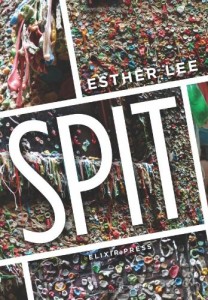 Spit by Esther Lee | Elixir Press 2010 | $16
Spit by Esther Lee | Elixir Press 2010 | $16
What is spit, taken as the title of Esther Lee’s first book of poetry? It can be derogatory, can be DNA and genealogy, can be sustenance and suckling, can be used to form or deform the sounds we make when speaking. The poems in this collection are preoccupied with the mouth, which functions as a site of stagnation just as much as change. The book begins, “When asked if I believe in absolute truths, I cite the lie.” And a few lines down: “Our mouths were stretched to the floor as punishment . . .” In another poem, the mouth is a “rusted hollow,” an irreparably broken car muffler. Later, in “The Real World Is Like This,” the sound of a mother’s “bird-throat” suggests flight, then suggests the clicking sounds of the speaker’s tap shoes driving a rift between her and her sister and, she says, “what my mouth can’t afford.”
Astonishing for a first book, Lee’s signature style is instantly recognizable by the accent she creates visually on the page. The front dedication to her family reads: “I kiss one hundred time[ ].” Generally brackets tell of absence, which can mean revision, loss, or a truncated excess—and in these poems refer to text as much as to personal experience. In the dedication, it is a nod to her parents’ accent. In the “Interview with My [C]orean Father” poems, the bracketed “C” reclaims and reshapes an ethnic label. It also points out how arbitrary are such naming practices, since Corean and Korean sound identical. In “We Are the Happiest Children in the World” and “Ivan / Ivan,” brackets proliferate lines to evoke at once caesura and transition, as we see in:
I tell you I am here mingled [ ] with snow
yellow-white as the page [ ] I suckled from
my grandmother—strange mother—and I [ ] grew
These brackets have a distinct flavor from backslashes, m-dashes, and ellipses; they are a ligature of grammatical pedantry (showing Lee in command of the language) and ungrammatical familiarity (an intuitive, poetic experimentation). They are a punctuation that Lee has made uniquely her own in these poems.
Another trademark is Lee’s blank missives, also the title of her first chapbook and interspersed throughout Spit. The opening poem is titled, “Dear __________cate,” and signed, “Yours, / __________cate.” These symmetrical blanks suggest epistles sent from one unfinished self to another, or between variable selves. They also invite the reader to participate in meaning-making. Some blanks require an obvious part of speech: __________est, __________phobic. Some suggest a theme or emotion: __________quito, __________pling. Others can be difficult to fill in, like __________eam, and resist the standard proportioning of suffixes. Part of Lee’s play is appropriating the English language and making it her own.
“Tongues for ‘Typhoid Mary’ ” unexpectedly thrusts Mary Mallon into a wordplay of difficult English sounds, including consonant clusters that might be mispronounced by an immigrant: “freshly fried / flying fish, shredded Swiss at sixish. Truly, rurally.” Together with limerick-quick rhymes, Lee’s technique makes a fable out of Mary Mallon. Historically, she was the first known healthy typhoid-fever carrier, and the cognomen “Typhoid Mary” today conjures malignant ignorance and a refusal to cooperate with officials for the “greater good.” Her story is also one of alienation and quarantine, all for the crime of inhabiting her own body. She even changed her name to Mary Brown, hoping to blend in. In Lee’s poem, Mallon’s immigrant background is subtle but present: “Eyeing her Irish wristwatch, she winced since / no selfish shellfish could ease her mood.” The enjambment is telling.
Lee’s sly command of the language sometimes borders on evasion of plain statement; in other words, poetical occlusion. But behind the trumpet of her poems one can usually hear a gasp of breath, a human frailty and voice. And I wonder if her poetic vision is not unlike Mallarme’s, who wrote of the difficult poet: “he hesitates to divulge too brusquely things which do not yet exist; and thus, in his modesty, and to the mob’s amazement, he veils them over.” These subdermal poems roil in family and experience, and get under your skin even when refusing a nominalist simplicity. They feel more than tell; they do more than mean. Take, for instance, the poet’s interviews with her father, which begin as a back-and-forth exchange, then fragment across the page until the conversation meets a gorgeous incoherence. In the third interview, the speaker asks, “Then why stop playing soccer?” and the father answers, “I met you dressed as a bumblebee. My arms fit / around like a honeycomb.” To which the response is: “The leaking / fish market boxes.”
This first book of poems astounds the immigrant narrative. In Spit, we learn that protest and testimony are insufficient lyrics of an older generation; yet, neither are these poems sounding the mechanical jazz of language poetry. Spit is concentrated voice, kaleidoscopic narrative. Expect this poet to impact the present generation, to unveil the lies we tend to cite—which no longer suffice.
One thought on “Review: Esther Lee’s SPIT”